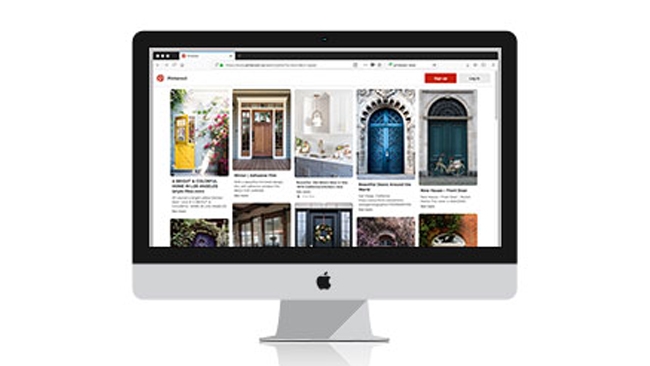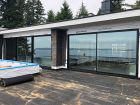
Articles
Dealer’s Corner
Entrances: I saw this door on Pinterest…
Meeting the challenges of the internet-powered door customer.
June 22, 2018 By Treena Hein
 This is what your customer sees when she searches “doors” on Pintrest. What, you can’t deliver a replica of a medieval cathedral door that meets code?
This is what your customer sees when she searches “doors” on Pintrest. What, you can’t deliver a replica of a medieval cathedral door that meets code? As you might know firsthand, we now live in the age of the internet-savvy consumer – those who research every corner of the internet for ideas and solutions for everything from home renovations to healthcare. But if you ask door-makers (or doctors, veterinarians, farmers and many more, for that matter) whether internet browsing on sites like Houzz or Pinterest can be a case of too much of a good thing, the answer will likely be a resounding yes.
Serving customers that have seen ‘the perfect door’ online before they present themselves at your place of business can be rife with difficulty. These customers can be dead set on the specific door they want, and they even often have a photo of it on their mobile device in order to show you exactly what they’re after. One of the top challenges in these situations, notes Cynthia Wood, sales and customer service manager at Maritime Door and Window in Moncton, New Brunswick, is trying to explain that the product desired will just not perform adequately in the Canadian environment. “They might be looking at photos from California and many doors that meet code there will not meet code in our cold, wet conditions,” she says. “Even though we tell this to the customers, they often don’t care or don’t think they care at the time because they have their heart set on something specific. The fear here [for us] is when the product fails, as it inevitably will, you run the risk of damaging your reputation, but if you don’t [somehow meet their needs], then you run the risk of them shopping elsewhere.”
Another problem with customers seeking the door of their dreams is that the door in question simply won’t work in particular dwellings. “The door might be too large for the opening,” says Wood, “or even if it will fit, it will be too heavy or thick to install.” She adds that in addition, the door might also “simply be something that isn’t available from anyone in the area.”
And, even if the ‘internet door’ is are able to handle the Canadian climate and is possible to install, it may be out of a customer’s price range. “They’ll frequently be looking at something custom-made and not realize the quality and cost will be quite different from an off-the-rack product,” says Wood. “These products are super costly so there is some shock and negative feelings about ‘gouging,’ especially when they have already priced a ‘normal’ door for the same hole.” She adds that making custom doors requires quite a bit of time, “and you have to try to explain that as well.”
Zane Yaniw, procurement manager at Supreme Windows in Calgary, Alberta, confirms that he often sees these issues of sticker shock and unhappiness with extended lead times for special order products. “They’ll go to other cheaper suppliers and then to us, so we get the difficult orders and try to make it work,” he explains. He notes that the cost to produce a door that provides the look that a customer is after but also meets Canadian regulations can indeed be very high, at least $60 000. Yaniw says that while doors for existing homes in renovations that don’t require a permit can involve much more flexibility with regulations, but that new construction is very strict.
Yaniw has also seen many a customer who have gone on the internet and found an off-the-rack door they really love, but once they are told it’s not available in Canada, they have a hard time believing it. “They really don’t accept that news,” he says. “They’ve looked at our website and seen our list of suppliers and they’ll say ‘your supplier offers it, so you can get it,’ and we have to tell them that these companies just won’t ship some products to Canada. They just won’t. It’s deflating for them.”
At Westeck Windows in Chilliwack BC, John Neal reports that customers generally come in with door ideas and not demands for doors they’ve seen online. “From time to time, we have requests for a specific door style but then we can talk them into a different style,” says the firm’s vice president of manufacturing. “As long as we are informed and know our products, this works. We feel that when we specify back to the customer what he or she should have, as the designers, we typically have fewer issues and customer complaints. This has been a sales tactic that has worked the best. If you allow a customer to pick from 100 options, it just creates confusion and opens the possibility for communication error.”
In Wood’s view, the worst aspect of being approached for internet dream doors can come after the door is ordered, finished and installed. “It isn’t what they thought or they don’t like it as much as they thought they would,” she says. “We are limited by how much we can show in the showroom and we can’t prebuild every idea a customer has, so sometimes it is all done off graphics or photos and reality is not always as good as it looks on Pintrest. This is especially true with some of the colours people ask us to paint doors. It may look neat on a colour chip but that doesn’t mean it will look great as your front door. Crazy colours for the front door is really popular right now.”
Technical challenges
Besides sales challenges, there can also be thorny difficulties on the technical side for custom orders that spring from internet inspiration. In new home construction, Yaniw says it can be difficult to maintain North American Fenestration Standard, Energy Star and building zone regulations. “In the renovation sphere, the challenges are the lead times,” he notes. “There are also special handling requirements for product size and finishes.” Some new training has been required at Supreme Windows to meet these challenges, and the firm has also added the capacity to install multi-point locks.
Maritime Window and Door is another door maker that has added an in-house set-up for multipoint locks so that it can accommodate taller doors without a longer lead time. In addition, they’ve added an eight-foot patio in their showroom so customers can understand the weight and see what these doors look “in the flesh” compared to a traditional patio door. “The same goes for the glazed doors,” says Wood. “We really work hard to discourage accordion doors but we have been talked into selling a few that were between sunrooms and houses. There are more and more people requesting monster combinations and there is a real struggle to get them to site and installed because of the size and weight. We frequently have to ship things without glass in them and have even had to hire a crane truck to deliver and off-load doors.”
She adds that on the repair side, accordion doors are a challenge to fix because the knowledge just isn’t there. “Lastly, doors with the glass glazed in are really costly to replace if the seal in the glass fails,” she notes, “or it gets scratched or broken.”
Print this page


Leave a Reply